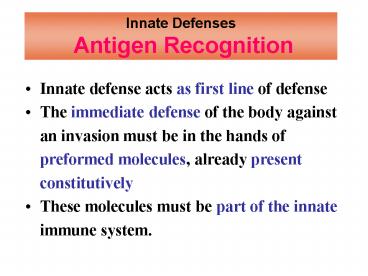Innate defense acts as first line of defense - PowerPoint PPT Presentation
1 / 11
Title:
Innate defense acts as first line of defense
Description:
Title: PowerPoint Presentation Last modified by: novin Created Date: 1/1/1601 12:00:00 AM Document presentation format: On-screen Show Other titles – PowerPoint PPT presentation
Number of Views:119
Avg rating:3.0/5.0
Title: Innate defense acts as first line of defense
1
Innate Defenses Antigen Recognition
- Innate defense acts as first line of defense
- The immediate defense of the body against an
invasion must be in the hands of preformed
molecules, already present constitutively - These molecules must be part of the innate immune
system.
2
Innate Defenses Antigen Recognition
- The innate immune system functions by recognizing
highly conserved sets of molecules - These molecular structures are specific to the
microbes (pathogen-associated molecular patterns,
or PAMPs) through a limited set of germ line
encoded receptors called pattern-recognition
receptors (PRRs) - Adaptive immune system uses T -cell receptors
(TCRs) and B -cell receptors (BCRs) with the
ability to recognize a large spectrum of antigens - There are several distinct classes of PRRs, each
of which is involved in performing specific tasks - These include opsonization, activation of
complement cascade, phagocytosis, etc.
3
Innate Defenses Antigen Recognition(PRRs)
- First, PRRs recognize microbial components, known
as pathogen-associated molecular patterns
(PAMPs), that are essential for the survival of
the microorganism and are therefore difficult for
the microorganism to alter - Second, PRRs are expressed constitutively in the
host and detect the pathogens regardless of their
life-cycle stage - Third, PRRs are expressed on all cells of a given
type, and independent of immunologic memory - Different PRRs react with specific PAMPs, show
distinct expression patterns, activate specific
signaling pathways, and lead to distinct
antipathogen responses - The basic machineries underlying innate immune
recognition are highly conserved among species,
from plants and fruit flies to mammals
4
Innate Defenses Antigen Recognition (TLRs)
- A class of PRRs called Toll-like receptors (TLRs)
has the ability to recognize pathogens or
pathogen-derived products and initiate signaling
events leading to activation of innate host
defenses - Signaling by TLRs initiates acute inflammatory
responses by induction of anti-microbial genes
and inflammatory cytokines and chemokines - Subsequent events, such as recruitment of
neutrophils and activation of macrophages, lead
to direct killing of the microbes - The notion of TLRs is primary sensors of
pathogens and responsible for orchestrating the
innate responses - TLRs contribute significantly to activation of
adaptive immune responses
5
Innate Defenses Antigen Recognition
- There are 10 TLRs, named TLRs 110, known in
mammals - These receptors recognizes molecules derived from
a unique class of microbial agents - TLR4, for example, recognizes lipopolysaccharide
(LPS), which is unique to Gram-negative bacteria - TLR2 recognizes peptidoglycan, which is abundant
in Gram-positive bacteria - TLR3 recognizes double-stranded RNA from
double-stranded viruses - TLR7 and 8 recognize RNA from single-stranded
viruses - TLR9 recognizes unmethylated CpG DNA found
abundantly in prokaryotic genomes and DNA viruses
6
Host-Pathogen Interplay
- Despite this armory of ready-made weapons, the
fact that specific immune antibody is required to
prevent some infections - Often this is because the invading organism has
evolved some mechanisms for escaping destruction - Examples of this include the capsule of certain
bacteria which prevents innate recognition. Some
species of bacteria and protozoa actually welcome
phagocytosis, having devised means of surviving
inside the phagosome or cytoplasm of the cell,
phagocytosis helps hide them from other immune
mechanisms - Because of their short generation times pathogens
will always hold an advantage in the cat and
mouse game of immunity.
7
Adaptive immune responseCells Associated
- T cells
- B cells
- Dendritic Cells
- Other Effector cells
8
Adaptive Defenses T Lymphocytes
- T lymphocytes constitute the "cellular" arm of
acquired/specific immunity - T lymphocytes play a central role in controlling
the acquired immune response - serve as crucial effector cells through antigen
specific cytotoxic activity and the production of
soluble mediators called lymphokines (the
cytokines produced by lymphocytes) - There are two major subsets of T lymphocytes that
differ in effector function, MHC restriction and
accessory molecule usage
9
Adaptive DefensesT cell receptors
- T lymphocytes express a clonal antigen-specific
receptor - Each T cell posses just one type of receptor, so
that all of the receptors from one cell can only
recognize one antigen - The T cell receptor (TCR) is in fact very similar
to Immunoglobulin - It has 2 paired polypeptide chains both of which
have constant and variable portions and both of
which are composed of immunoglobulin-like domains - Two important differences are
- a) TCR is monovalent
- b) It exists only as a cell surface receptor and
has no counterpart to secreted antibody - Unlike immunoglubolin, they are MHC restricted
10
Adaptive DefensesT cell receptors
11
Adaptive DefensesT cell receptors































